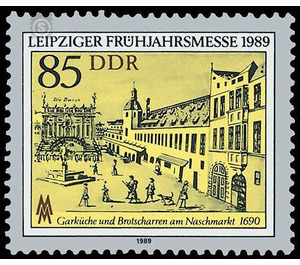Commemorative stamp series - Germany / German Democratic Republic 1989 - 85 Pfennig
Theme: Animals
| Country | Germany / German Democratic Republic |
| Issue Date | 1989 |
| Face Value | 85.00 |
| Color | brown |
| Perforation | K 14 |
| Printing Type | offset |
| Stamp Type | Postage stamp |
| Item Type | Stamp |
| Chronological Issue Number | 2978 |
| Chronological Chapter | GER-DDR |
| SID | 857860 |
| In 12 Wishlists | |
Leipzig Spring Fair 1989 On the occasion of the Leipzig Spring Fair 1989, the Ministry of Posts and Telecommunications of the German Democratic Republic issued two multicolored postage stamps. Special cancellation from March 7 to May 6, 1989 80th anniversary of the trade fair house "Handelshof" The trade fair house "Handelshof" commemorates its 80th anniversary in 1989. This special anniversary stamp is dedicated to the Leipzig spring fair in 1989. On the 70th anniversary It is worth taking a look today at the third largest Leipzig trade fair center and at the 85 Pfennig value the housing complex with communal facilities of the trading city previously located on the location of the "Handelshof." The Leipzig graphic artist and engraver Oswin Volkamer has drawn both from the same angle - for example from the entrance to the The square between "Naschmarkt", "Grimmaischer Straße", "Reichsstraße" and "Salzgäßchen" in the immediate vicinity of the Old Town Hall was dominated by urban buildings for centuries, and between 1560 and 1670 the salt house, the meat Market , the food stall and the shoe store. The food stall housed the "Burgkeller" also a restaurant, which - first mentioned in 1419 - is considered the oldest gastronomic institution in Leipzig. However, the current location of the west side of the trade fair house "Handelshof" probably is not identical to the original location. The entire complex of the street quarter - a total of 13 houses - was demolished in 1906 to create construction freedom for the trade fair building "Handelshof". The architects Georg Wiedenbach and Richard Tschammer designed the building, grouped around two atriums, with four imposing fronts leading to the narrow streets. The "Handelshof" was specifically designed for sample measurement requirements and offers ideal exhibition conditions with its access from all sides and complete tours. It was completed in 1909 as the second municipal "Mustermesse-Palast" after the exhibition center "Städtisches Kaufhaus". The exhibition space is more than 10 000 square meters, which means the third place among the trade fair buildings in the center of Leipzig. On the ground floor next to the already mentioned "Burgkeller" numerous trade and service facilities are housed in an ideal location in the middle of the city. During the Second World War, the "Handelshof" was hit hard: in December 1943 he burned down to the ground floor after bomb attacks on Leipzig. But already at the Spring Fair 1947, three floors could be used again for the exhibitors. The entire reconstruction was not completed until 1960. But since then, there has always been renovation and beautification work on this large house, which is located directly at the junction of two ancient trade routes - the via regia (Königsstraße) and the via imperii (Reichsstraße) - also impressed all visitors to the trade fair metropolis today. At every trade fair, the industry complex Technology for Home and Leisure offers current offers from all over the world. Leading issue "Flexible Automation" A separate postal stationery with the impression of the motive of the 70 Pfennig value and changed value 1.35 Mark is dedicated to the main topic of the Leipziger Messen 1989 "Flexible Automation". With this new topic the Leipziger Messen 1989 put a problem of international importance in the center of the fair happening. It is about increasing automation of production, ensuring high productivity and product quality. Flexible automation means automating production more effectively by using microelectronic control and computing technology, as well as robot technology, and achieving short changeover, processing and loading times on the machines. Especially in the metalworking industry, the glass and ceramics industry, the light industry, construction and other industrial sectors, the domestic and foreign exhibitors of the Leipziger Messen 1989 with higher machines, machining centers, modules, systems and lines, state-of-the-art processing technologies and new software solutions Demonstrate the efficiency of their offer.


